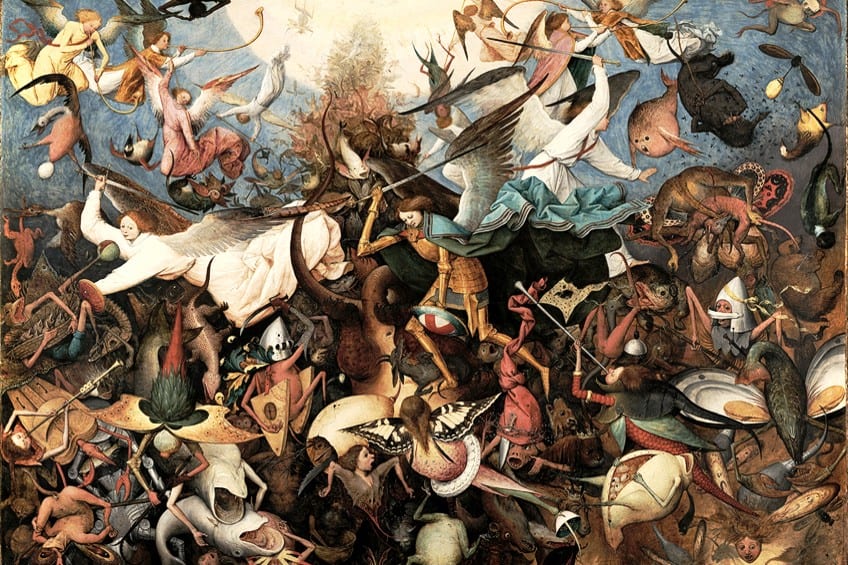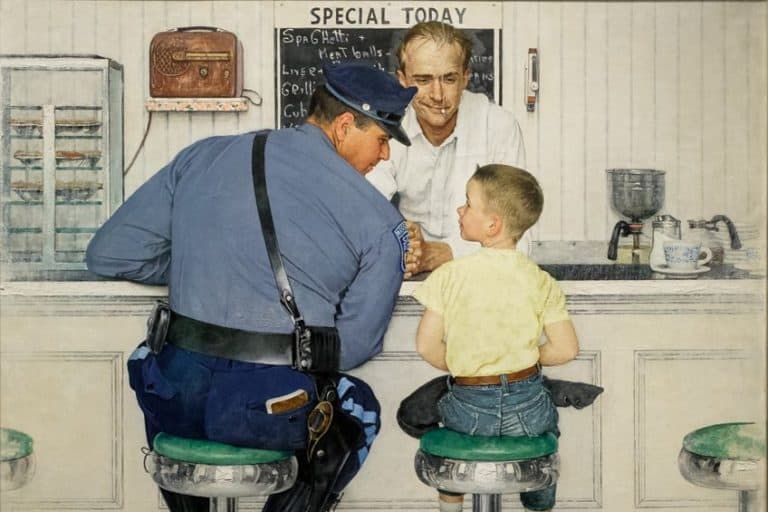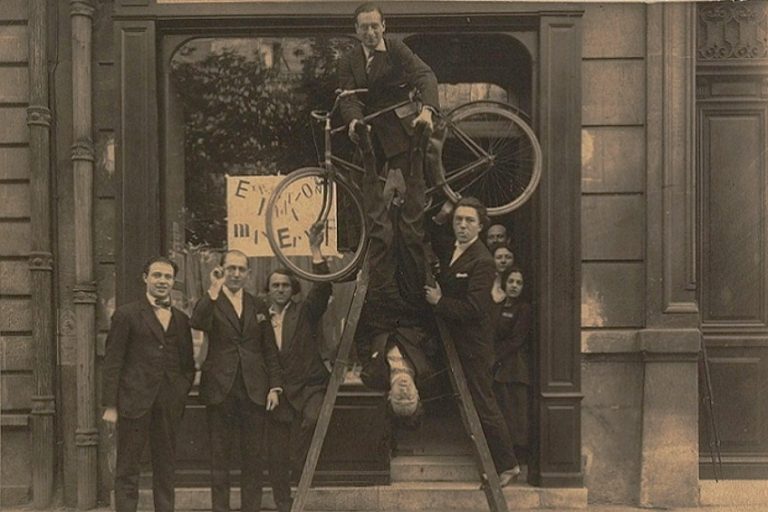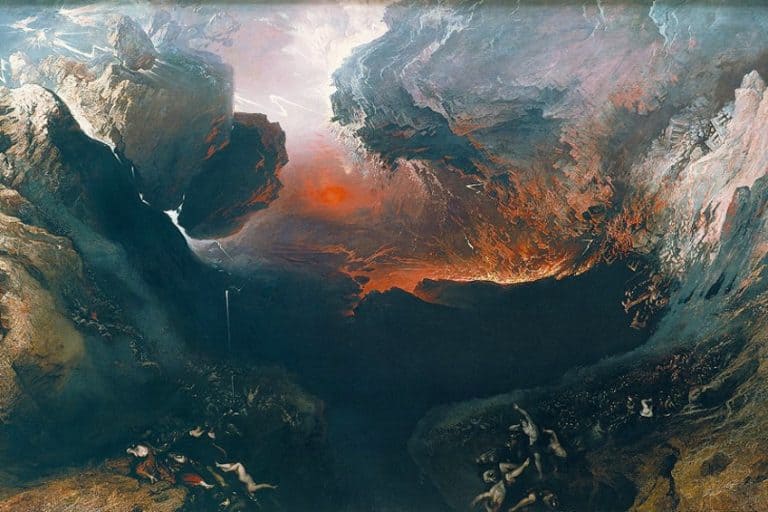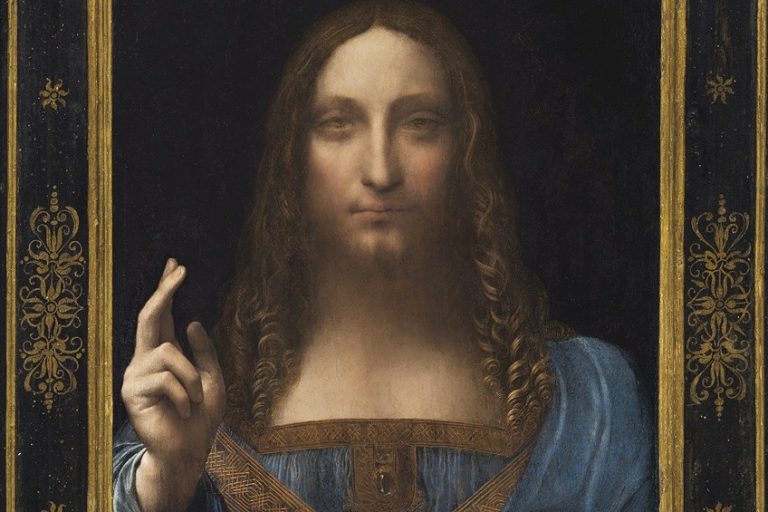“The Fall of the Rebel Angels” by Pieter Bruegel the Elder – A Look
As one of the foremost Northern Renaissance artists, Pieter Bruegel the Elder created visual stories that could keep you entertained for days on end. This article will explore one of his religious paintings titled The Fall of the Rebel Angels (1562), which explored the timeless theme of good and evil.
Artist Abstract: Who Was Pieter Bruegel the Elder?
Pieter Bruegel the Elder was a Netherlandish artist whose date of birth is obscure, but the birth year was possibly between 1525 to 1530. His birthplace has been posed as close to the city of Breda. His death was dated September 9, 1569, in Brussels, Belgium.

He was known for his subject matter related to peasantry, mythological, and religious subject matter, also with a focus on the everyday. Some of his famous artworks include Landscape with the Fall of Icarus (c.1558), The Hunters in the Snow (1565), and The Harvesters (1565).
The Fall of the Rebel Angels (1562) by Pieter Bruegel the Elder in Context
| Artist | Pieter Bruegel the Elder |
| Date Painted | 1562 |
| Medium | Oil on panel |
| Genre | Religious painting |
| Period/Movement | Dutch/Flemish Renaissance art |
| Dimensions (cm) | 117 x 162 |
| Series/Versions | N/A |
| Where Is It Housed? | Royal Museums of Fine Arts of Belgium in Brussels, Belgium |
| What It Is Worth | It was reportedly purchased by the museum in 1846. The price is uncertain. |
The Fall of the Rebel Angels analysis will explore the meaning of the painting in further detail, starting with a brief historical background, which will be followed by a discussion of the visual composition and what the subject matter consists of.
Contextual Analysis: A Brief Socio-Historical Overview
The Fall of the Rebel Angels meaning can be found in the age-old symbolism of light triumphing over dark, or otherwise Good and Evil. It illustrates the Biblical passage from the Book of Revelation, namely Chapter 12 when the Devil and all his angels were cast out of Heaven by Archangel Michael and his angels.
A Question of Bosch
Reportedly, Pieter Bruegel the Elder was also influenced by the unique subject matter of Hieronymus Bosch’s paintings. An interesting fact is that Bruegel has often been described as a “Second Bosch” because of the resemblance of compositional style and painting techniques utilized.
The triptych “The Garden of Earthly Delights” (c. 1490 – 1510) and “The Last Judgment” (c. 1482) are just two of Bosch’s famous oil paintings that are believed to have influenced Pieter Bruegel the Elder.
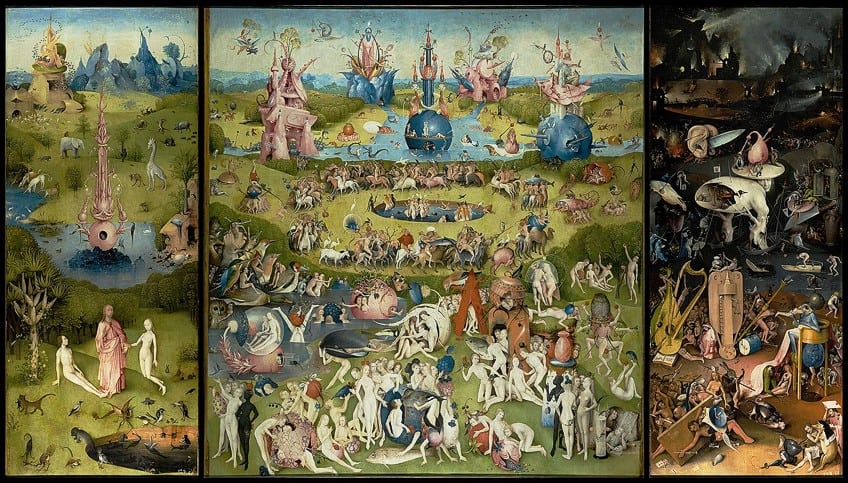
Formal Analysis: A Brief Compositional Overview
In The Fall of the Rebel Angels analysis, you will read more about the formal qualities of this painting. It will first be introduced through a visual description of the subject matter and then how the art elements compose it.
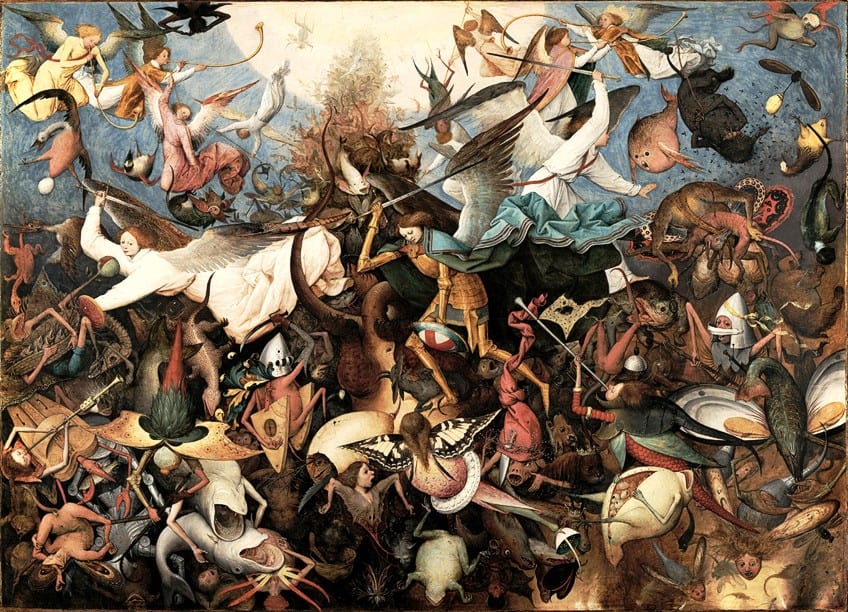
Subject Matter: Visual Description
The Fall of the Rebel Angels by Pieter Bruegel the Elder depicts a lively scene filled with a variety of animalistic creatures and figures being slain by angels. Upon closer examination, the scene can also be viewed according to two horizontal sections. The upper section of the composition depicts the blue sky with a large semi-circular golden-yellow orb in its center. This is possibly the sun, which appears to be an access point to Heaven, which is represented by this upper section of the composition.
There are several angels in the upper third of the composition, which also appears less crowded than the lower two-thirds. Some of the angels are playing trumpets, notably to the left and right edges, and others are in the process of killing the hybrid bird-reptilian-fish-like creatures.
A large swarm of figures is visible falling from the sun, are possibly the fallen angels cast out of heaven. Their formation forms a falling tower that spreads out across the lower two-thirds of the composition, creating a cramped and dense space of writhing and screaming creatures. This lower section is representative of Hell, which is inevitably waiting the further down the figures fall.
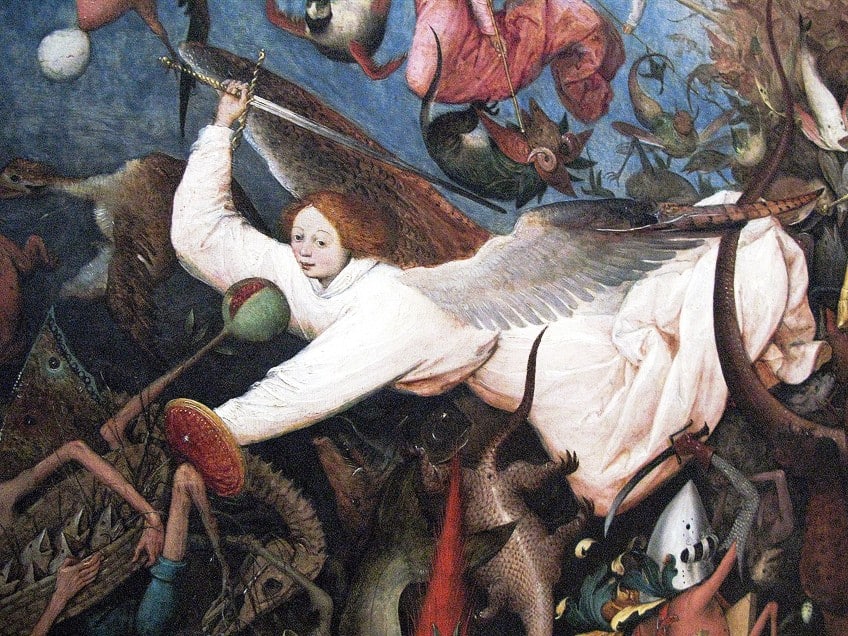
In the center of the lower section is the Archangel Michael, with two beautifully big angel wings, he wears a blue cape and golden armor. His sword is in his right hand and lifted above his head. He is in the process of killing a dragon-like creature below him. In his left hand is a shield with a red cross. His facial expression is calm compared to the apparent suffering of the fallen. To Archangel Michael’s right (the viewer’s left) is another angel wearing a white robe, easily identified amidst the dark density of figures, and also holding up a sword in his right hand.
Another angel is noticeable behind Archangel Michael holding a sword in his right hand. All these angels are in the process of slaying the creatures around them.
Nature and Objects
It has widely been mentioned that Pieter Bruegel the Elder could have been inspired by what is known as a cabinet of curiosities. The Fall of the Rebel Angels painting depicts various objects and animals that appear aquatic, amphibian, reptilian, avian, and various insects. These could have been observed studies.
For example, notice the pair of butterfly wings on the figure’s back below Archangel Michael, which is reportedly from the Papilio machaon butterfly or the blowfish towards the upper right corner.
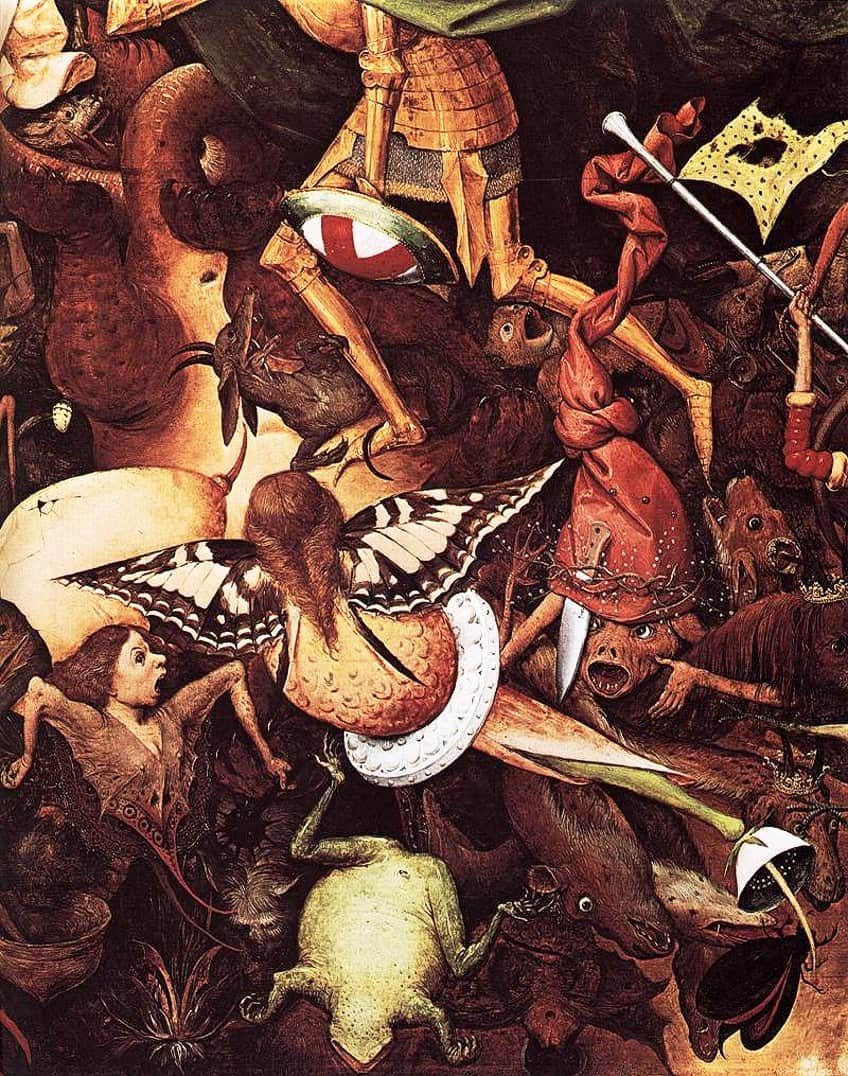
Other items that are not from the natural world include weapons and several pieces of armor, what appears to be a sundial, musical instruments like a Hurdy-Gurdy, and a red turban on one of the creatures positioned just off-center, among many others.
Color
There is a defining contrast of colors in The Fall of the Rebel Angels by Pieter Bruegel the Elder, which also acts as a division between the upper and lower sections of the composition. For example, the upper third appears in lighter blues and yellows, which gradually transition to earthier browns and ochres, and neutral blacks, which convey shadows and density.
There are various other colors of the creatures like darker reds, greens, and some grays.
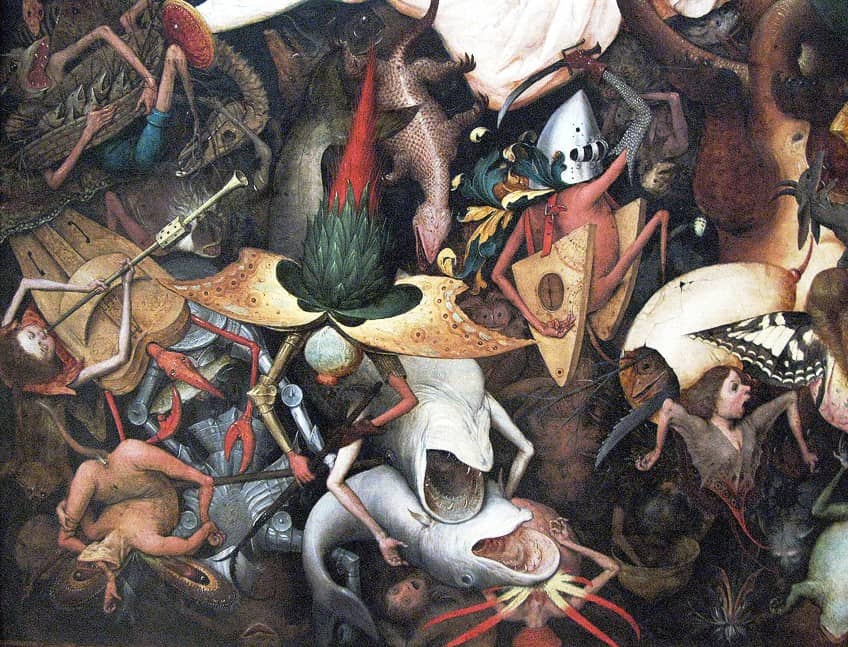
The contrast between light and dark is also demonstrated by the angel in the stark white robe to the left of the composition who appears, seemingly, as a white light among the darker figures. Additionally, Archangel Michael’s light blue cape with an apparent darker green inner almost becomes a sliver of light among the dark shadows.
Texture
Pieter Bruegel the Elder painted in a variety of textures in The Fall of the Rebel Angels painting, which he achieved through brushstroke effects like impasto or sfumato, which creates a sense of realism in the composition.
Examples, where the texture is implied, include the linear and somewhat thicker brushstrokes that suggest the angels’ wings and the smoother brushstrokes on Archangel Michael’s armor that appear as a harder surface compared to the softer appearance of his blue cloak.

There are also finer brushstrokes giving the reptilian creatures a smoothed body surface as well as the plants, which appear spindly and hairy, for example, the green and red bulb-like structure that appears to be growing out of the back of the figure to the left of the composition.
Line
There are a variety of lines in The Fall of the Rebel Angels painting, all composing the figures and creatures, from diagonal, straight, curved, thick, and thin. These also create a sense of dynamic movement and rhythm, which creates a harmony of lines even though the composition appears haphazard and filled.
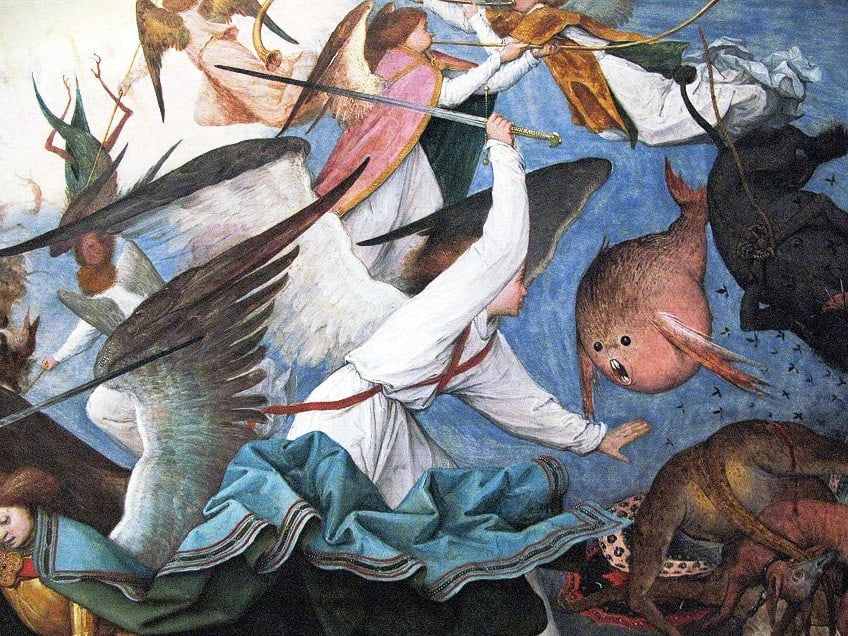
Shape and Form
There is a plethora of shapes and forms in The Fall of the Rebel Angels painting, and it appears dominantly as a naturalistic composition, which consists of shapes and forms that are rounder, more curved, and irregular, which are evident in the natural world. However, there is a subtle combination of geometric shapes like the triangular shape of what is thought to be a sundial, slung over the front and back of the creature a little below the angel in a white robe to the left.
The semi-circular shape of the sun above also creates a contrasting effect against the random and irregular shapes below it. The upper section is minimal in form while the lower section is filled with movement.

Space
Pieter Bruegel the Elder depicted a full compositional space for The Fall of the Rebel Angels painting. There are almost no open areas except for the more spacious sky above. The artist also conveyed a sense of depth through techniques like shading, overlapping, blurriness, and scale.
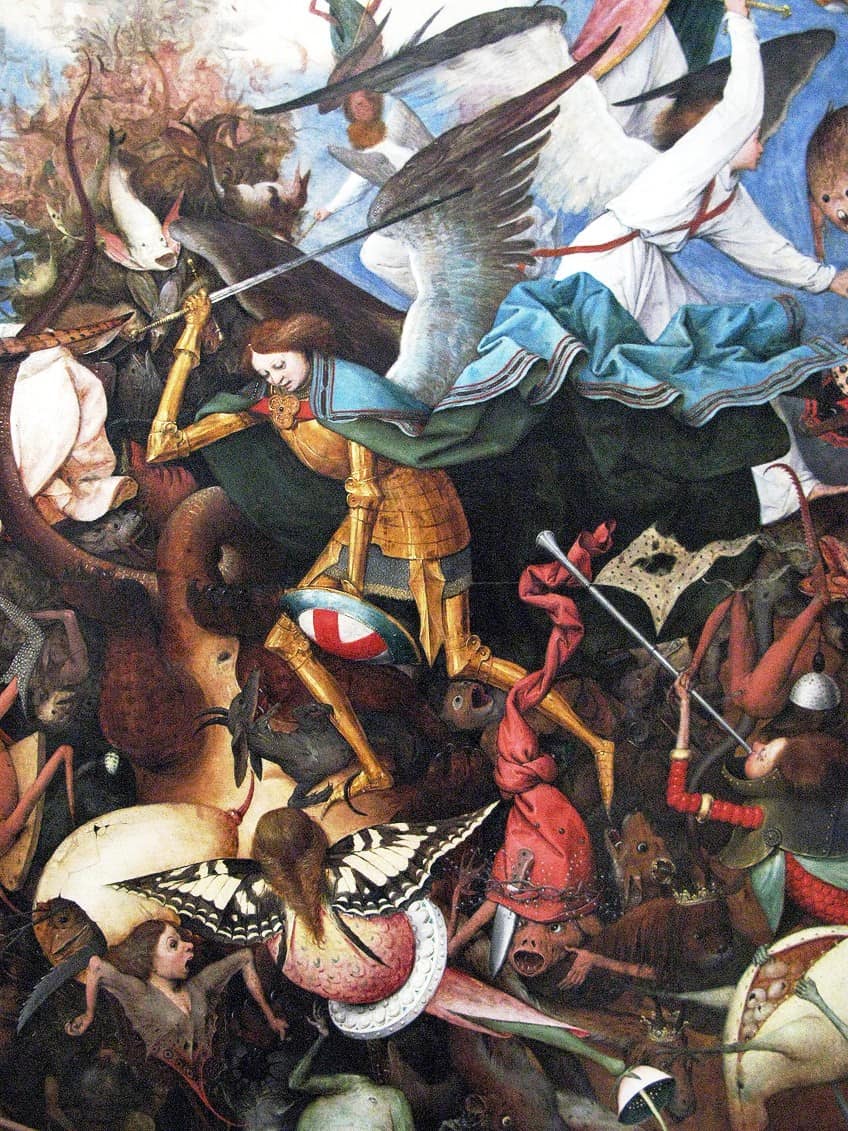
For example, the large tower of figures falling from the sun is depicted as lighter, as if almost hazy and not in focus, which creates the idea of distance the further away they are from the foreground of figures, who are all visible to us, the viewers.
Furthermore, these are overlapping figures, which also creates a sense of depth and more three-dimensionality.
The Rise of Bruegel’s Message
What The Fall of the Rebel Angels by Pieter Bruegel the Elder depicts is a message that moves beyond just a religious narrative, but one that also touches on the political and social aspects of life. It is an example of how Bruegel turned to timeless themes to give rise to his message of what many may have experienced during the time he lived.

“The Fall of the Rebel Angels” analysis explored the painting in more detail and the Biblical inspiration that informed the subject matter, which includes mention of masters like Hieronymus Bosch, who was another significant inspiration for Bruegel the Elder. Although there seems to be limited knowledge about Bruegel’s life, significant depth of artistry and storytelling can be deduced from his seemingly otherworldly compositions.
Frequently Asked Questions
Who Painted The Fall of the Rebel Angels?
The Netherlandish painter, Pieter Bruegel the Elder, was known to have painted The Fall of the Rebel Angels (1562). It is an oil on oak and measures 117 by 162 centimeters. It was initially believed that Pieter Bruegel the Younger and Hieronymus Bosch painted it, but due to the date and artist’s signature, it was corrected to Bruegel the Elder.
What Is The Fall of the Rebel Angels Meaning?
The overall meaning of The Fall of the Rebel Angels (1562) by Pieter Bruegel the Elder is about ideas of good versus evil. The subject matter is religious and depicts Lucifer (evil) and the angels (good) in a conflicting scene of banishment from Heaven.
Where Is The Fall of the Rebel Angels Located?
Pieter Bruegel the Elder’s painting, The Fall of the Rebel Angels (1562), is located at the Royal Museums of Fine Arts of Belgium in Brussels, Belgium. It was acquired by the museum in 1846.
Alicia du Plessis is a multidisciplinary writer. She completed her Bachelor of Arts degree, majoring in Art History and Classical Civilization, as well as two Honors, namely, in Art History and Education and Development, at the University of KwaZulu-Natal, South Africa. For her main Honors project in Art History, she explored perceptions of the San Bushmen’s identity and the concept of the “Other”. She has also looked at the use of photography in art and how it has been used to portray people’s lives.
Alicia’s other areas of interest in Art History include the process of writing about Art History and how to analyze paintings. Some of her favorite art movements include Impressionism and German Expressionism. She is yet to complete her Masters in Art History (she would like to do this abroad in Europe) having given it some time to first develop more professional experience with the interest to one day lecture it too.
Alicia has been working for artincontext.com since 2021 as an author and art history expert. She has specialized in painting analysis and is covering most of our painting analysis.
Learn more about Alicia du Plessis and the Art in Context Team.
Cite this Article
Alicia, du Plessis, ““The Fall of the Rebel Angels” by Pieter Bruegel the Elder – A Look.” Art in Context. July 7, 2023. URL: https://artincontext.org/the-fall-of-the-rebel-angels-by-pieter-bruegel-the-elder/
du Plessis, A. (2023, 7 July). “The Fall of the Rebel Angels” by Pieter Bruegel the Elder – A Look. Art in Context. https://artincontext.org/the-fall-of-the-rebel-angels-by-pieter-bruegel-the-elder/
du Plessis, Alicia. ““The Fall of the Rebel Angels” by Pieter Bruegel the Elder – A Look.” Art in Context, July 7, 2023. https://artincontext.org/the-fall-of-the-rebel-angels-by-pieter-bruegel-the-elder/.


